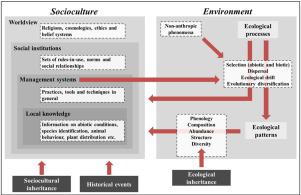Perspectives in Ecology and Conservation ( IF 4.7 ) Pub Date : 2021-03-03 , DOI: 10.1016/j.pecon.2021.02.008 Juliano Franco-Moraes , Charles Roland Clement , Joana Cabral de Oliveira , Alexandre Adalardo de Oliveira

|
Indigenous peoples and local communities (IPLC) manage over half of the world’s landscapes, and this management involves landscape transformations associated with their sociocultures. Although anthropologists have shown that IPLC sociocultures influence management, and historical-ecological studies have shown that this management influences environments, how interactions between IPLC sociocultures and environments influence landscape transformations is less clear. Here we use a historical-ecological approach and a cultural niche construction perspective to present an IPLC landscape transformation framework that identifies and integrates sociocultural and environmental elements. Our framework shows that IPLC’ landscape transformations occur through cultural niche construction and are influenced by historical events. IPLC sociocultures influence ecological processes and patterns through interactions that create sociocultural and ecological inheritances. These inheritances involve IPLC worldviews and associated norms, practices and knowledge which influence ecological processes that, in turn, engender ecological patterns. On the other hand, ecological processes and patterns influence IPLC sociocultures as they are perceived and processed according to local worldviews, so generating sociocultural–environmental feedbacks. To exemplify our framework, we present cases of cultural niche construction by Amazonian IPLC that show how interactions between sociocultures and environments influence landscape transformations. We argue that understanding how IPLC sociocultures have interacted with environments can help scientists, conservation practitioners and policymakers to combine scientific knowledge production, biodiversity protection and IPLC’ well-being.
中文翻译:

确定和整合土著人民和地方社区景观转变的社会文化和环境因素的框架
土著人民和地方社区(IPLC)管理着世界一半以上的景观,这种管理涉及与其社会文化相关的景观转变。尽管人类学家已经表明,IPLC社会文化会影响管理,而历史生态学研究表明,这种管理会影响环境,但是,IPLC社会文化与环境之间的相互作用如何影响景观转换尚不清楚。在这里,我们使用历史生态学方法和文化生态位建设视角来提出一个IPLC景观转型框架,该框架可以识别并整合社会文化和环境要素。我们的框架表明,IPLC的景观转变是通过文化生态位建设而发生的,并受到历史事件的影响。IPLC社会文化通过产生社会文化和生态遗产的相互作用来影响生态过程和模式。这些继承涉及IPLC世界观以及相关的规范,实践和知识,这些影响生态过程,进而形成生态格局。另一方面,生态过程和模式会影响IPLC社会文化,因为它们是根据当地的世界观进行感知和处理的,因此产生了社会文化-环境反馈。为了举例说明我们的框架,我们介绍了Amazonian IPLC构建文化生态位的案例,这些案例说明了社会文化与环境之间的相互作用如何影响景观转换。我们认为了解IPLC社会文化如何与环境互动可以帮助科学家,


























 京公网安备 11010802027423号
京公网安备 11010802027423号